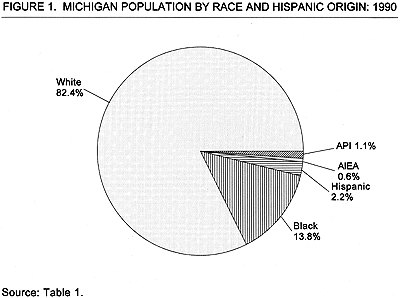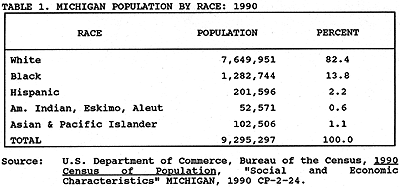|
The perception that the growth of the Latino population is an immigrant phenomenon is related to the false notion that many of the immigrants are Latino. In Michigan, Latinos represented an insignificant share of the state's immigrant population. The 25,114 foreign born Latinos in Michigan accounted for only 7.1% of the foreign born population of 355,393 in the state. Mexico accounted for over 54% of the state's Latino immigrant population but only for 3.8% of the state's immigrant population - the same, incidentally, as the proportion of Michiganians that were foreign born. According to the 1990 Census, the countries that contributed to the immigrant population of Michigan more than Mexico were Canada with 15.4%, Germany with 6.8%, Italy and Poland with 5.2% each, and Iraq with 4.0%. The predominance of the U.S. born Latino population in Michigan reflects a historical connection between this population group and the state's need for labor that dates back to the turn of the century
Mexicans and Mexican-Americans were first recruited from regions in south Texas in the early 1900's, to work either in the sugar beet industry or as railroad workers. During World War II, they were also recruited to staff defense factories. Over the years, many of these workers stayed, including agricultural workers who settled in communities which offered year-round employment. This process gave way to the establishment and development of Latino communities, which now exist in urban and rural areas throughout the state.
The growth rate over the decade for Latinos in Michigan ranged from a high of 205.5% in Chippewa County, to a decline of 6.1% in Huron County (MNVREP, 1991). Thus, the browning of the state varied considerably from place to place, despite the fact that the major share of Michigan's growing Latino population was composed of natives. The events that attracted Latinos to particular places, as well as the experiences of Latinos and the ways they were welcomed as citizens in the communities where they settled, also varied from place to place. The social, economic, political, and cultural impacts the growing Latino presence has had on the different Michigan counties, cities, towns, and villages where they have come to reside have also been varied.
The Hispanic or Latino population in Michigan is quickly becoming a more prominent member of the community. This is partly due to the group's increased population size, but it is also due to their impressive representation in the labor force, a representation among school-aged youth as well as their rapidly increasing presence in the business world. However, as subsequently shown, poverty and underrepresentation in high income jobs continue to be areas of needed attention for the advancement of Michigan's Latinos.
Role In The Midwest
Michigan currently holds the second highest number of Hispanics in the Midwest, after Illinois. While there are no places in the state that contain a majority or even sizable minority (greater than 25 percent) of the state's Latinos, nearly three quarters of the state's Hispanics reside in the ten most populous counties, all of which are in the lower portion of the lower peninsula (the so-called "downstate counties"). These counties contain the state's capitol and major cities; hence, Latinos' patterns of settlement, centering on key areas of the state's governance and commercial activities, also contribute to their increased prominence.
Relatively Young
The state's Latinos are a relatively young population, as are the nation's Latinos in general. The average age for the group in Michigan is about 23.1 years, as against an average of 32.6 for the state as a whole. In relative terms, Hispanics are overrepresented within the state's population of school age children and young adults. Therefore, schooling and effective placement in the state's labor market is a considerable concern of Latinos.
Diverse Within
"Hispanics" as a group are not entirely homogenous within this categorization. They constitute a population of several different national-origin groups with specific unifying themes. One such characteristic is Spanish, often the first language spoken at home and among family and friends. Another is a proclivity towards special historic and culture events. The major groups, in terms of numeric strength in Michigan as well as the United States, are Mexican-origin Latinos, Puerto Ricans, and Cubans. The remaining groups, often categorized as "other Hispanics," cover Latinos from South, Central America, and even Spain.
In 1990, as shown in Figure 1, Hispanics accounted for only 2.2 percent of Michigan's total population. However, this proportion represents an increase from the 1980 proportion of only 1.8 percent. As noted in the figure, over 80 percent of the majority of the state's residents are White. Blacks, the largest racial minority, accounted for nearly 14 percent of the total, with Hispanics the second largest of the groups depicted in the figure. The remaining groups combined comprised less than 2 percent of the state's people.


This Statistical Brief paints just a part of a picture of Michigan's Hispanics. The profile shown is that of a unique population, growing at a time when non-Latino Whites are shrinking in number. The youthfulness of Latinos and their proclivity for labor force participation also point out that jobs and education are relevant policy concerns. So too is the spectre of poverty, which is extremely high in Michigan. For the gap in income to close between Latinos, non-Latino Whites, and Asian and Pacific Islanders, much more research and policy analysis will be urgently needed in the coming years.
Michigan LCLAA
Labor Council for Latin American Advancement
Reaching Out to Latino Workers
Latino workers are the fastest growing minority workforce in the state and often are exposed to dangerous work. One out of every two new workers in the U.S. are immigrants.
According to the Bureau of Labor Statistics, Latino workers have the highest rate of industrial injuries compared to white and black workers. Some experts believe that workplace injuries are under-reported because immigrant workers fear deportation or losing their jobs, or an unscrupulous employer fails to file an injury report.
Origins of the Movement
The 1950 brought many Latino activists to the forefront of the civil rights movement. These activists struggled to begin opening the doors of opportunity for the community by building solidarity and promoting economic justice for all working people. In 1972, Latino trade unionists from all across the United States and Puerto Rico joined together to make a commitment to the Latino community and pledged to fight for the rights of working people.
These trade unionists fundamentally believed that through the union movement & the electoral process, Latinos would be able to strive for social dignity, economic equality, access to the political process and a higher quality of life for every Latino working family. These ideals became part of the American Dream for Latino working families. With this dream in mind, these Latino trade unionists made a commitment to the Latino community and formed the Labor Council for Latin American Advancement (LCLAA), an organization dedicated to achieving this American dream for all Latino workers through the promotion of the union movement.
LCLAA works with Latino union members to advocate for the rights of all Latino workers and their families at all levels of the American trade union movement and the political process. LCLAA strives to achieve social and economic equality for each and every Latino worker by developing programs that reach out and educate Latino workers about the importance of participating in the political process in order to ensure a strong voice for Latino working families.
An AFL-CIO Constituency Group
As an AFL-CIO constituency group, the Labor Council for Latin American Advancement is a bridge to diverse communities, creating and strengthening partnerships to enhance the standard of living for all workers and their families. The groups also promote the full participation of minorities in the union movement and ensure unions hear and respond to the concerns of the communities they represent.
Today, these constituency groups are investing new energy to support workers' efforts to join unions to improve their lives, drawing upon close ties in local communities to rally support for workplace justice. They have developed a common agenda focusing on six areas of mutual concern: promoting organizing and the freedom of workers to choose a union, encouraging women and minorities to participate in the political process, fighting discrimination, defending immigrant rights, building Union Cities and protecting retirement security.
I focused on the Latin population growth and labor in Michigan. Latino people and workers have been growing fast. They’ve supported the auto industry in Detroit and done many hard workings which usually Americans hesitate or dislike with low rate of payment. However, in development and inequality in the market economy some problems exist in Michigan. According to the Bureau of Labor Statistics, Latino workers have the highest rate of industrial injuries compare to white and black workers. These problems should be solved with corporation and the government and people have to be educated.
|

